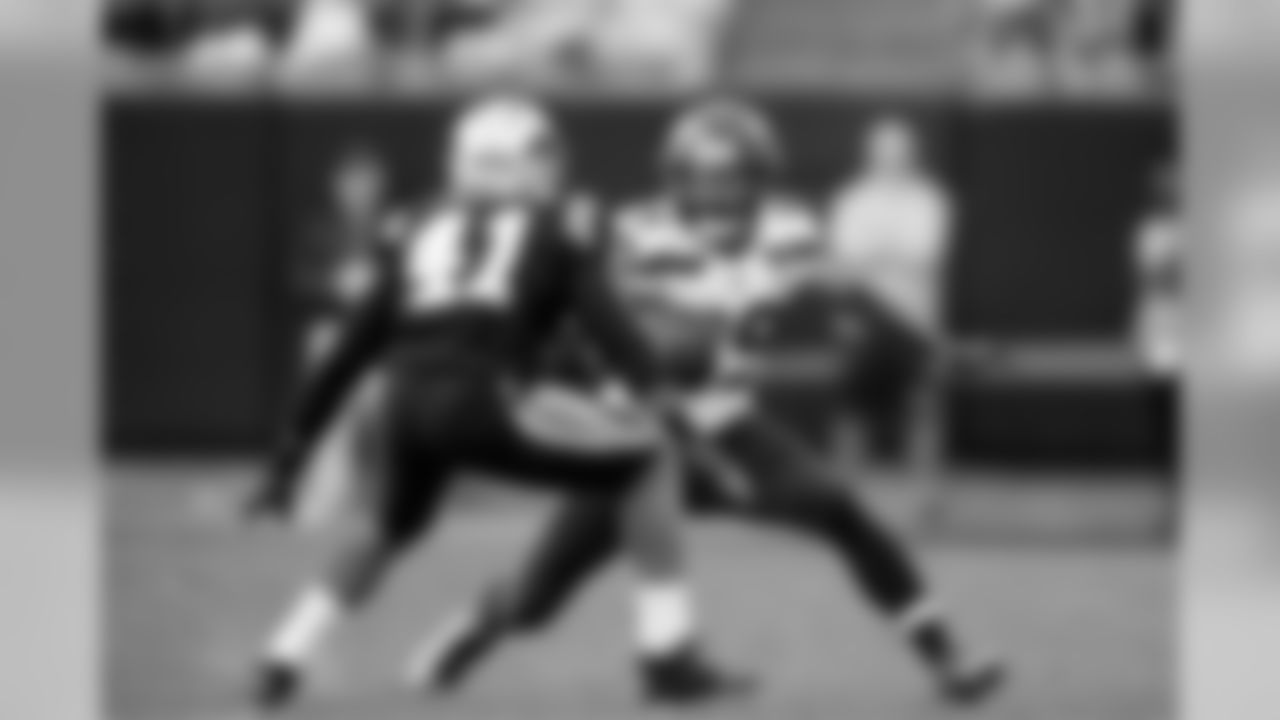CHARLOTTE—The Seahawks scored on each of their final five possessions, including three touchdowns, in large part because of big plays made in the passing game.
In their dramatic 30-27 win over the Carolina Panthers, the Seahawks rushed for just 75 yards, averaging 2.7 yards per carry, and passed for 339 yards, averaging 10.9 yards per attempt. And as paradoxical as it may sound, those lopsided numbers perfectly illustrated the type of balance Seahawks coach Pete Carroll wants to have in an offense.
A common misperception of Carroll's teams is that he wants to have a run-first offense, but if you listen to Carroll talk offensive philosophy, the term he uses over and over is balance, not run-first. But when Carroll says balance, he doesn't mean he wants to have a certain run-to-pass ratio in every game, or rush for a certain number of yards every game; to Carroll, balance means being able to call upon the running game or the passing game when needed in order for the offense to do what it takes to win.
Coming into this week's game, the Seahawks had rushed for more than 150 yards in seven straight games, the longest such streak in franchise history, but the combination of Carolina's talent in its front-seven and its commitment to stopping Seattle's running game made for a tough day on the ground for the Seahawks. But what Carolina's commitment to stopping the run also did was give Russell Wilson and his receivers more chances to make big plays in the passing game, and Wilson responded by completing 22 of 31 attempts for a season-high 339 yards, two touchdowns and a 128.3 passer rating. Wilson completed seven explosive passes (16-plus yards) to five different targets: David Moore, Tyler Lockett, Tre Madden, Malik Turner and Doug Baldwin. Those big plays included a 35-yard touchdown to Moore that tied the game with under four minutes left to play, as well as a 43-yarder to Lockett that set up the winning field goal. Big catches by Lockett (27 yards) and Madden (28 yards) set up a 1-yard Chris Carson touchdown run in the second quarter, and a 54-yard pass to Moore set up a 12-yard touchdown pass to Lockett.
"On a day when we couldn't run the ball like we had been, we needed the throwing game, and Russ came through and had a great day throwing the football," Carroll said. "He just found so many key plays in crucial situations, and did a wonderful job of making plays down the stretch when we had to have them. Guys made the catches, and the pass protection was there for us. We love to run the football, but balance is what's really the essence of this thing, and I'm thrilled we were able to do that."
The Seahawks were balanced in the first half in the traditional sense, rushing 14 times and throwing 12 passes, but those 14 runs led to only 50 yards, and the Seahawks punted on three of their first four possessions.
"They did a good job against us," Carroll said. "That's a really good, stellar front. They've got three fantastic linebackers, they're monsters inside, it was just really hard."
Added Wilson, "It was definitely hard (to run the ball). Those linebackers and that D-line are pretty good, but to be able to throw the ball—we can do anything we want to do. We've got star receivers out there on the flank, we've got tight ends who can catch, we've got running backs who can catch, we've got guys who can protect really well, so there's nothing we can't do. We want to play tough, physical football, but we also want to be able to be explosive in the passing game, spread the ball around, and guys made plays when we needed them to."
In the second half, the Seahawks threw 19 passes and ran it 14 times, though two of those 14 were kneel downs late in the game prior to Sebastian Janikowski's game-winning field goal, so it was really a 19-12 ratio. With the threat of the run still credible even without a lot of big gains, Seattle's passing game opened up in the second half, with Wilson throwing for 218 of his 339 yards and both of his touchdowns.
"We've got to make them keep (playing the run) so we can use the play-action stuff and get the ball over the top of them," Carroll said. "That's part of it, if they've got to commit that hard (to stopping the run), it does give us some space to throw the football, and that's how it fits together. (Offensive coordinator Brian Schottenheimer) has to balance that out, and he did a great job today. This is not a surprise that they played us really tough in the running game. You saw (Schottenheimer) had a variety of things he went to today, all kinds of good stuff to get the ball down the field, and the key to it was that the protection held up as the game went on and gave us a chance."
Again, balance doesn't mean a certain number of runs for the Seahawks, it means having the running game and passing game both available when needed. And unlike recent games when the Seahawks have had huge rushing games, they won on Sunday in large part because of an explosive passing game.
"That's the whole point," Carroll said. "You don't know, sometime it ain't going to work, and you've got to be able to go the other way, or if you get behind, you need to go to the throwing game. We don't think we're not going to throw it, we want to take advantage of it off of the running game. That's no secret, so I don't mind saying it."
Seattle's offensive line has taken pride in the way it has paved the way for big running games in recent weeks, but on Sunday it was that unit's ability to protect Wilson, who wasn't sacked in the second half on those 19 pass attempts, that played a big role in a victory.
"They did a good job playing our run today," center Justin Britt said. "We like to say we're not one-dimensional, we're not just a run-first team. We preach about being balanced, and today the passing attack was the thing that kept us going and the thing that kept us in the game, and ultimately that won the game. Our backs did a hell of job when their opportunities came, but it was some tough sledding."
Game action photos from the Seahawks' 30-27 win against the Carolina Panthers in Week 12 of the 2018 NFL season.



























